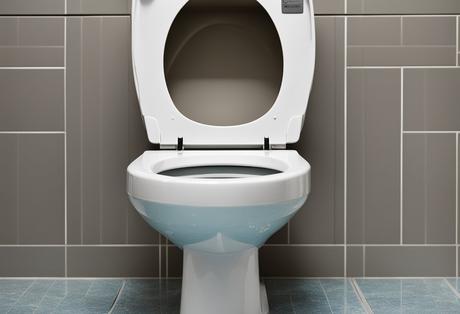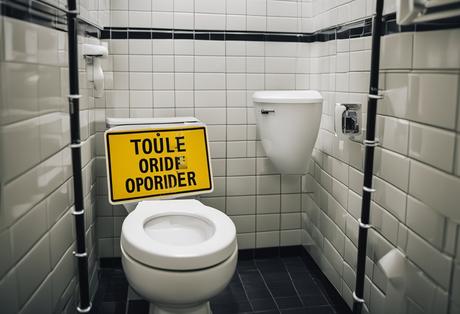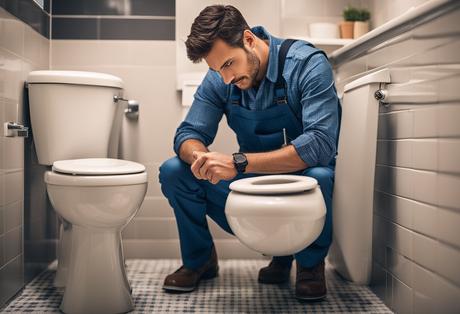A non-flushing toilet can be a frustrating and embarrassing issue to deal with. It can lead to a messy and unhygienic situation, and if not fixed promptly, can cause further damage to the plumbing system. Fortunately, there are several solutions to fix a toilet that won’t flush properly, even if it’s not clogged.

To understand how to fix a non-flushing toilet, it’s essential to have a basic understanding of the mechanism of a toilet. A toilet has two main components: the tank and the bowl. The tank stores water and releases it into the bowl when the flush lever is pressed. The water then pushes the waste through the trapway and into the drainpipe. If any of these components malfunction, the toilet won’t flush properly.
There are several common reasons why a toilet won’t flush, even if it’s not clogged. These include a faulty flapper, low water level in the tank, a blocked rim jet, or a malfunctioning fill valve. Fortunately, most of these issues can be fixed with some basic tools and a little know-how. In this article, we’ll provide a step-by-step guide to fix a non-flushing toilet, as well as some preventive measures to keep your toilet running smoothly.
Key Takeaways
- A non-flushing toilet can be caused by several issues, including a faulty flapper, low water level, or a blocked rim jet.
- Understanding the mechanism of a toilet is essential to fixing a non-flushing toilet.
- With some basic tools and know-how, most non-flushing toilets can be fixed at home.
Understanding the Mechanism of a Toilet
Toilets are one of the most essential fixtures in any home or building, but most people don’t understand how they work. A toilet consists of two main parts: the bowl and the tank. The bowl is the part of the toilet that holds water and waste, while the tank is the part that holds the water used for flushing.
When you flush a toilet, the handle is connected to a chain that lifts a flapper valve at the bottom of the tank. This allows water to flow from the tank into the bowl, which creates a siphon effect that pulls waste and water out of the bowl and down the drain.
The tank then refills with water, which is controlled by a fill valve. Once the tank is full, the fill valve stops the flow of water. The toilet is now ready for the next flush.
There are several components in a toilet that can cause it to not flush properly, even if it’s not clogged. These include a malfunctioning flapper valve, a broken or loose chain, a low water level in the tank, or a clog in the rim jets or siphon jet.
It’s important to understand how a toilet works so that you can troubleshoot any issues that arise. By knowing the basic mechanism of a toilet, you can identify the problem and fix it quickly and easily.
Related Posts:
- The Best Close Coupled Toilet
- The Best One-Piece Toilets
- The Best Macerating (Upflush) Toilets
- Best Toilet Seat for Heavy Person
Common Reasons for a Non-Flushing Toilet
A toilet that won’t flush can be a frustrating and embarrassing problem. There are several reasons why a toilet may not flush properly, even if it’s not clogged. Here are some of the most common causes:
- Low water level in the tank: If the water level in the toilet tank is too low, there may not be enough water to create a proper flush. This can be caused by a faulty fill valve or a problem with the water supply. Check the fill valve and water supply to make sure they are working properly.
- Worn-out or malfunctioning tank components: The flapper, flush handle, or button may be worn out or malfunctioning, preventing the toilet from flushing properly. Check these components and replace them if necessary.
- Clogs in the rim jets: The rim jets are the small holes around the rim of the toilet bowl that help to create a powerful flush. If these holes become clogged with mineral deposits or other debris, the toilet may not flush properly. Use a wire hanger or small brush to clean out the rim jets.
- Damaged float: The float is the mechanism that controls the water level in the tank. If the float is damaged or not working properly, it may not allow enough water into the tank for a proper flush. Check the float and replace it if necessary.
- Drain blockage: If none of the above solutions work, there may be a blockage in the drain pipe that is preventing the toilet from flushing properly. Use a plunger or a drain snake to clear the blockage.
By identifying the cause of the non-flushing toilet, you can take the necessary steps to fix the problem and restore your toilet’s proper function.
Related Posts:
- The Best Toilet Cleaner UK
- Gerber Toilet Reviews
- The Best Toilet Seat For Hemorrhoids
Step-By-Step Guide to Fix a Non-Flushing Toilet
When a toilet won’t flush, it can be a frustrating experience. Fortunately, many non-flushing toilet issues can be resolved without the need for a plumber. This step-by-step guide will help you troubleshoot and fix your non-flushing toilet.
Checking the Toilet Handle
The first step in fixing a non-flushing toilet is to check the toilet handle. Sometimes, the handle can become loose or disconnected from the flapper chain, preventing the toilet from flushing. To check the handle, remove the tank lid and flush the toilet. If the handle feels loose or disconnected, tighten the nut or reattach the chain as needed.
Inspecting the Flapper
If the toilet handle is not the problem, the next step is to inspect the flapper. The flapper is the rubber valve that opens and closes to allow water to flow from the tank to the bowl. Over time, the flapper can become worn or damaged, preventing it from sealing properly and causing the toilet to not flush. To inspect the flapper, remove the tank lid and flush the toilet. If the flapper does not lift or reseal properly, it may need to be replaced.
Examining the Water Level
Another common cause of a non-flushing toilet is an incorrect water level in the tank. If the water level is too low, the toilet may not flush properly. To check the water level, remove the tank lid and look at the water level mark on the inside of the tank. If the water level is below the mark, adjust the float arm or fill valve as needed to raise the water level.
Unclogging the Overflow Tube
If the toilet handle, flapper, and water level are not the problem, the next step is to check the overflow tube. The overflow tube is a small pipe located in the center of the tank that prevents the tank from overflowing. If the overflow tube becomes clogged with debris or mineral buildup, it can prevent the toilet from flushing properly. To unclog the overflow tube, use a wire hanger or other long, thin object to clear any blockages.
Related Posts:
- The Best No Clog Toilets
- The Best Toilet Brush UK
- The Best Wall Hung Toilets
Preventive Measures for a Non-Flushing Toilet

To avoid having a non-flushing toilet, it is essential to take preventive measures. One of the easiest preventive measures is to avoid flushing anything other than toilet paper and human waste down the toilet. Flushing items such as paper towels, feminine hygiene products, and baby wipes can cause clogs that prevent the toilet from flushing correctly.
Another preventive measure is to clean the toilet regularly. Mineral buildup and debris can accumulate in the toilet bowl, causing blockages that prevent the toilet from flushing correctly. Using a toilet cleaner and brush to clean the toilet bowl regularly can help prevent these blockages.
It is also essential to make sure that the toilet tank is functioning correctly. Checking the tank for leaks, adjusting the water level, and replacing any worn-out parts can help ensure that the toilet flushes correctly.
Finally, considering upgrading to a newer, more efficient toilet can also prevent non-flushing issues. Dual-flush toilets and high-efficiency toilets use less water per flush, which can help prevent clogs and other issues.
Related Posts:
- The Best Dual Flush Toilets
- The Best Flushing Toilet
- The Best Toilet Seat UK
When to Call a Professional

If the toilet won’t flush even after trying all the troubleshooting tips, it’s time to call a professional plumber. A trained plumber will be able to diagnose the problem and fix it quickly and efficiently. Some of the issues that require the attention of a professional plumber include:
- Broken or damaged toilet components: If the toilet’s components such as the flapper, flush handle, or button are worn out or damaged, a professional plumber will be able to replace them.
- Blocked sewer line: If the toilet is not clogged, but still won’t flush, the problem could be a blocked sewer line. A professional plumber will be able to use a plumbing snake or hydro jet to clear the blockage.
- Low water pressure: If the toilet is not getting enough water pressure, it won’t flush properly. A professional plumber will be able to diagnose the cause of low water pressure and fix it.
- Faulty toilet tank: If the toilet tank is cracked or damaged, it will not hold enough water to flush properly. A professional plumber will be able to replace the toilet tank.
If the toilet is not flushing properly, it’s important to call a professional plumber as soon as possible to avoid further damage to the toilet or the plumbing system.
Related Posts:
- The Best Toilets UK
- The Best Toilet Paper UK
- The Best Tankless Toilets
Frequently Asked Questions
How do I fix a toilet that won’t flush even though it’s not clogged?
If your toilet won’t flush even though it’s not clogged, there are a few things you can try. First, check the water level in the tank and adjust it if necessary. If the water level is too low, the toilet may not flush properly. You can also check the flapper to make sure it’s opening and closing properly. If the flapper is worn or damaged, it may need to be replaced. Finally, check the chain that connects the flush lever to the flapper. If the chain is too loose or too tight, it can prevent the toilet from flushing properly.
What should I do if my toilet won’t flush after plunging?
If your toilet won’t flush after plunging, there are a few things you can try. First, make sure the water level in the tank is high enough. If the water level is too low, the toilet may not flush properly. You can also try using a toilet auger to remove any blockages that may be deeper in the pipes. If all else fails, you may need to call a plumber to diagnose and fix the problem.
Why won’t my toilet flush all the way unless I hold the handle?
If your toilet won’t flush all the way unless you hold the handle down, there may be a problem with the flapper or the chain that connects the flush lever to the flapper. Check the flapper to make sure it’s opening and closing properly, and check the chain to make sure it’s not too loose or too tight. If the flapper is worn or damaged, it may need to be replaced.
How can I fix a weak flushing toilet?
If your toilet is flushing weakly, there are a few things you can try. First, check the water level in the tank and adjust it if necessary. If the water level is too low, the toilet may not flush properly. You can also try cleaning the rim holes around the inside of the bowl to improve water flow. Finally, check the flapper to make sure it’s opening and closing properly. If the flapper is worn or damaged, it may need to be replaced.
What could be causing my toilet to fill up with water and drain slowly?
If your toilet is filling up with water and draining slowly, there may be a blockage in the pipes. You can try using a plunger or a toilet auger to remove the blockage. If that doesn’t work, you may need to call a plumber to diagnose and fix the problem.
How do I fix a loose toilet flush handle?
If your toilet flush handle is loose, you can try tightening the mounting nut that holds the handle in place. If that doesn’t work, you may need to replace the mounting nut or the handle itself.
Related Posts:
- The 10 Best Toilet Seat of 2020
- The Best Self Cleaning Toilets
